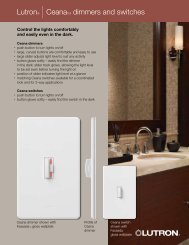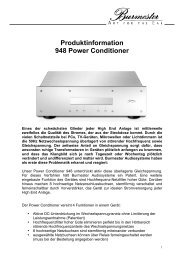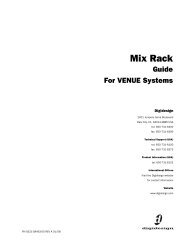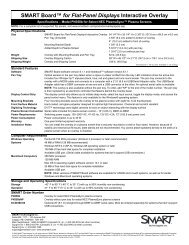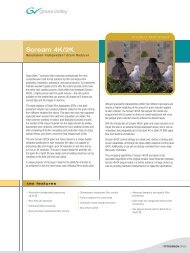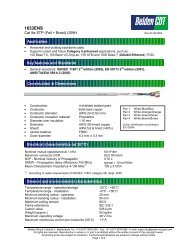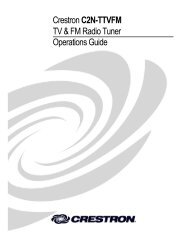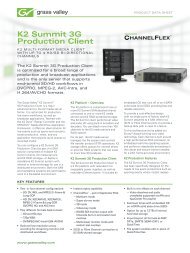Quickfly Operating Manual - Meyer Sound Laboratories Inc.
Quickfly Operating Manual - Meyer Sound Laboratories Inc.
Quickfly Operating Manual - Meyer Sound Laboratories Inc.
You also want an ePaper? Increase the reach of your titles
YUMPU automatically turns print PDFs into web optimized ePapers that Google loves.
away from the wooden cabinet. L-Track-equipped cabinets,<br />
in use with an MTG-4 top grid or MRF-6 rigging frame,<br />
ensure that an almost straight pull exists through the L-<br />
Track and connection fittings in a column of flown loudspeakers.<br />
An MTG-4-based system is illustrated in the following<br />
figure (Figure 1).<br />
Figure 1<br />
Direction of Pull Stress<br />
3. RIGGING OVERVIEW AND SAFETY ISSUES<br />
3.1 IMPORTANT NOTICE TO QUICKFLY OWNERS AND<br />
USERS<br />
PLEASE READ THIS SECTION CAREFULLY AND IN ITS<br />
ENTIRETY. IT CONTAINS CRITICAL INFORMATION REGARD-<br />
ING SAFETY ISSUES, INCLUDING GUIDELINES FOR GENERAL<br />
SAFE USE OF RIGGING SYSTEMS AS WELL AS ADVISORIES<br />
ON GOVERNMENT REGULATIONS AND LIABILITY LAWS. MEY-<br />
ER SOUND CANNOT BE HELD RESPONSIBLE FOR CONSE-<br />
QUENCES THAT MAY ENSUE DUE TO FAILURE TO READ AND<br />
COMPLY WITH INFORMATION IN THIS SECTION.<br />
3.2 SCOPE OF THIS MANUAL<br />
Although this manual contains much useful information<br />
on rigging in general, it does not claim to be a comprehensive<br />
resource on the subject. This manual assumes that<br />
the owners and/or users of a QuickFly system are knowledgeable<br />
and experienced in the areas of rigging and flying<br />
loudspeaker systems. Many issues of crucial concern,<br />
such as the determination of appropriateness and condition<br />
of venue rigging points, cannot be addressed here.<br />
Therefore, the user must assume all responsibility as to<br />
the appropriate use of the QuickFly system in any particular<br />
location or circumstance.<br />
The suspension of large, heavy objects in public places is<br />
subject to numerous laws and regulations at the national/federal,<br />
state/provincial and local levels. This manual<br />
does not address the specifics of any such applicable laws<br />
and government regulations. This manual details proce-<br />
The same principle applies to an MRF-6 rigging frame<br />
when mounted onto a Type 6 loudspeaker: the load<br />
stresses travel through the internal steel framework of the<br />
loudspeaker, bypassing the wood panels of the cabinets.<br />
The MRF-6 is bolted directly onto the steel frame (both<br />
top and bottom) of the Type 6 cabinet.<br />
In addition, QuickFly is designed to allow assembly of<br />
arrays without placing hands between the cabinets. All L-<br />
Track connections made between frames and/or Type 6<br />
and Type 4 cabinets are accomplished in front of or<br />
behind the loudspeaker. The only exception is when an<br />
MTG-4 Rigging grid is attached to the bottom of a Type 6<br />
array. However, in these cases, a greater space between<br />
cabinets will provide an increased safety margin.<br />
Please review the operating instructions that accompanied<br />
the particular loudspeaker cabinets used in the system for<br />
information on enclosure dimensions and rigging track<br />
locations.<br />
dures and practices consistent with those generally<br />
acknowledged as allowable and safe in the United States.<br />
However, the user must assume responsibility for making<br />
sure that use of the QuickFly system and its components<br />
in any particular circumstance or venue conforms to all<br />
applicable laws and regulations in force at the time.<br />
3.3 LOAD RATINGS AND SPECIFICATIONS<br />
Long-term safe operation is a central concern in the<br />
design and manufacture of any rigging/flying system.<br />
<strong>Meyer</strong> <strong>Sound</strong> has taken great care in material selection<br />
and component design. In all critical cases, load points<br />
are redundant, with a safety margin that allows one or<br />
more load points to fail and still maintain system integrity.<br />
After manufacture, all load-critical system components<br />
are individually inspected.<br />
All load ratings and other specifications given in this<br />
manual are the result of accepted engineering practice<br />
and careful testing. However, such specifications and ratings<br />
are subject to change. Users are advised to check the<br />
QuickFly section of the <strong>Meyer</strong> <strong>Sound</strong> web site (or contact<br />
<strong>Meyer</strong> <strong>Sound</strong> Technical Support) at regular intervals to<br />
check for updated or revised information.<br />
3.4 REGULATORY COMPLIANCE<br />
The engineering practices and Safe Working Load (SWL)<br />
ratings of the QuickFly system are in full compliance with<br />
all known regulatory statutes currently applicable in the<br />
4




